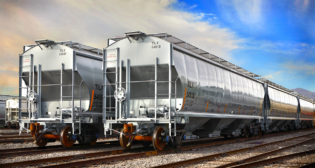
Commentary
REF 2024: Rail Equipment Close to Equilibrium; Structural Shifts May Emerge
Written by Matt Elkott, Transportation OEM Analyst, TD Cowen
Matt Elkott
We had one-on-one and group meetings with several rail and rail equipment stakeholders at the Rail Equipment Finance Conference 2024 (REF), held March 3-6 in La Quinta, Calif. Putting the pieces together, we would describe the current environment as one flirting with a sort of equilibrium, with the traffic outlook predictably modest, and service inching toward fluidity; and railcar builds around replacement, while lease rates remain strong.
TD Cowen takeaways from REF:
- We heard from industry participants from both the leasing and manufacturing arms of the industry who describe a potentially structural shift toward a less erratic build cycle, with builds hovering around replacement for the next few years, although with some variation on the definition of replacement as well as the specific production outlook. Lessors appear to see annual replacement as being 35,000-40,000 railcars, while the manufacturers’ definition range is likely 40,000-50,000 units. We see the disparity as a function, in part, of the sometimes inherently opposing interests of these stakeholders, and we believe 40,000 units may be a reasonable definition of replacement demand in a normalized environment. A modest, less cyclical build outlook could bode well for lessors and to a lesser extent manufacturers as it allows them to right size their footprint and reduce margin volatility. This more stable build outlook around replacement is a function of a structurally trimmed manufacturing capacity for the industry, elevated material costs, labor challenges, high interest rates, and anemic rail traffic. As far as the 2024 production forecast, we heard estimates as low as 32,000 units and as high as somewhat above 40,000 units. The industry’s consensus view may be around 38,000 units. We believe this number could be exceeded if the Mexico border issues are alleviated and barring further increases in steel prices and labor challenges. If it is exceeded, of the publicly traded builders, FreightCar America, The Greenbrier Companies, and Trinity Industries could benefit, in this order.
- We heard from more than one builder that inquiries have been solid in recent weeks; and one suggested that lead times may be a little less drawn out than in the last several months. These are two factors that could contribute to an upside surprise to this year’s build outlook, assuming, again, the Mexico border issues ease.
- Lease rates continue to be strong, although some lessors have seen a bit of easing in recent months. Given the modest build outlook this year, we do not see rates declining materially in the foreseeable future. This bodes well for continued fleet repricing for lessors such as GATX and Trinity Industries.
- With respect to the North American economy, our conversations with several industry stakeholders and experts suggest the absence of alarming fundamental cracks relating to the consumer or industrials, although risks associated with commercial real estate and interest rates and refinancing needs, among other things, should be monitored.
- The Class I’s need to continue to improve service further, including first and last mile, and go after highway freight more effectively. That’s the reverberating message that continued to be conveyed emphatically by various industry stakeholders. We continue to believe some of them may feel emboldened by the rail service issues of the past four years, which may have shone a light on PSR’s (Precision Scheduled Railroading) shortcomings and the rails’ margin fixation (although we note that global and port disruptions were also key culprits behind the rails’ inability to fully accommodate the pandemic’s freight demand surge).
- While further rail service improvement is necessary for meaningful modal share gain, one intermediate-term risk to equipment demand is if service does improve further this year but does not result in the intended volume additions if the economy and/or key end markets soften further. That would be a double headwind for railcars and locomotives.
- Secondary market valuations remain strong, but with slight easing in some pockets. The lease rate strength appears to be offsetting the negative impacts from high interest rates, keeping valuations elevated.



